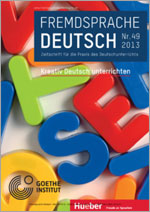Issue 2/2011 - ISSN 1470-9570
ARTICLES
Migrationen im 'Endreich': Zu visuellen
Geographien in Veit Harlans Jud Süß.
Carola Daffner, Southern Illinois (pages 1-16)
Traditionally studies of Nazi cinema have focused on its repeated depiction of a national community – a Volksgemeinschaft – which had to be purified of all foreign elements. Among these hate-mongering productions, Veit Harlan‘s masterpiece Jud Süß (1940) is considered one of the biggest coups of the Third Reich. In Harlan‘s extremely popular and highly anti-Semitic film, the historic figure Joseph Süβ Oppenheimer serves as a vehicle to engage collective fears of invasion on the screen. My article expands previous studies about the film‘s mass manipulation via the construction of an ‗other‘. Through an analysis of specific scenes, I show how Harlan‘s visual geographies negotiate an identity propagated by the social and racial utopias of the regime. Paradoxically, the spatial migration of the allegedly unwanted Oppenheimer becomes hereby a crucial and necessary catalyst in the strengthening of the imaginary National Socialist fantasy of space.
What (socio-)linguistic competences should we expect from teachers? Some suggestions inspired by German-speaking Switzerland.
Winifred V. Davies, Aberystwyth (pages 17-39)
In Switzerland there have recently been demands to improve pupils‟ first-language competence (Erstprachkompetenz) by ensuring that correct use of the first language is cultivated consistently in all subjects, not just in classes devoted to German, French, Italian or Romansch, i.e. all teachers should act as language norm transmitters. After discussing the specific sociolinguistic situation in germanophone Switzerland, I will examine critically this aspect of teachers‟ work against that background and will make suggestions how teachers can (and should) fulfil that role. Studies of German teachers in Germany have shown that, although they have positive attitudes towards standard German as an idea(l), there is nevertheless substantial disagreement amongst them as to how the standard should be realised in practice. If that is the case amongst subject specialists then we are justified in asking how realistic it is to expect teachers whose specialism is in another subject to be competent to transmit the necessary (socio)linguistic abilities. I will also discuss how prescriptive teachers should be and how their role is affected by the enormous range of linguistic diversity that characterises present-day society. Many of the issues will also be relevant to DaF teachers outside Switzerland or Germany.
German Studies in Australia: A Statistical Overview 1995-2010.
Heinz L. Kretzenbacher, Melbourne (pages 40-54)
The new Netzwerk Deutsch survey on German as a Foreign Language world-wide, following two previous surveys, provides a unique (if not entirely complete and comprehensive) overview of the development of the numbers of students of German internationally. This article discusses the numbers indicated for tertiary students of German in Australia and sets them in relation to the world-wide average, as well as to the numbers indicated for the other English-speaking OECD countries. The decline in student numbers has been less dramatic in the Anglophone OECD countries than in the world on average. Australian German Studies programs in particular have proved resilient in the face of the world-wide trend.
The State of German in the United States: A Statistical Portrait and a Call for Teachers.
Peter Ecke, Tucson (pages 55-83)
This article reviews data about German spoken at home, and German taught in U.S. elementary, secondary, and postsecondary educational institutions. It discusses data about U.S. students studying in Germany, U.S. teachers of German, doctoral research related to German conducted at U.S. universities, and employment opportunities for German language professionals. It is argued that the teaching of German is still in demand, and that the training of school teachers is the most important challenge to the profession. In order to meet this challenge, German Studies programs in colleges and universities need to do more to make teacher training a priority.
Lernwerkzeug Videokonferenz. Projekterfahrungen für das Lehren und Lernen des Deutschen als Fremdsprache.
Haymo Mitschian, Kassel (pages 84-125)
Als ein Lernwerkzeug für die Fremdsprachenvermittlung befindet sich die Videokonferenztechnik immer noch in einer Erprobungsphase. Die Erfahrungen aus einem deutsch-chinesischen Konferenzprojekt, die der Artikel beschreibt, werden mit denjenigen aus anderen, in der Fachliteratur berichteten Projekten abgeglichen, um die Spezifika des Lernwerkzeugs herauszustellen. Neben den Eigenschaften, die unmittelbar von der eingesetzten Technik bedingt werden, sind es vor allem die didaktischen Rahmenbedingungen zusammen mit den Besonderheiten der mediierten Kommunika-tionssituation – Stichwort: soziale Präsenz –, die sich als bestimmend erweisen und die in entsprechenden Lernsettings zu berücksichtigen sind.
Designing Web 2.0-Telecollaborations for University Students. The eExchange Giessen-Hong Kong.
Tushar Chaudhuri, Hong Kong (pages 126-41)
Reports on telecollaborative projects have frequently warned of problems and tensions that lead to failed objectives. To assess the success of online intercultural collaborations Dooly (2008: 159f) has provided teachers with a comprehensive check list starting with three fundamental questions: “What did we do right?”, “What things mattered most in this project?”, and “What things surprised us in this project that weren‟t in our plan?”. Keeping these questions in mind the following article will review a Web 2.0-based telecollaboration between the Hong Kong Baptist University and the Justus-Liebig-University Giessen which has been in demand with students for over five years. The article will focus primarily on the perspective of the Hong Kong Baptist University students and attempt to correlate the design of the project and the degree of success achieved for its participants, that is, to answer the question: What did we do right?
REVIEW
Handbuch Deutsch als Fremd- und Zweitsprache.
(2010) Hrsg. von Hans-Jürgen Krumm,
Christian Fandrych, Britta Hufeisen & Claudia Riemer
Rezensiert von Michael Szurawitzki (pages 142-49)
Das Hueber-Portal für DaF/DaZ-Kursleiter und –Lehrer bietet zahlreiche nützliche Online-Services für Ihren Unterricht: www.hueber.de/deutsch-als-fremdsprache
Besuchen Sie auch den Infoservice zu:
Fremdsprache Deutsch - Zeitschrift für die Praxis des Deutschunterrichts
Herausgegeben vom Hueber Verlag in Zusammenarbeit mit dem Goethe-Institut
www.hueber.de/fremdsprache-deutsch






